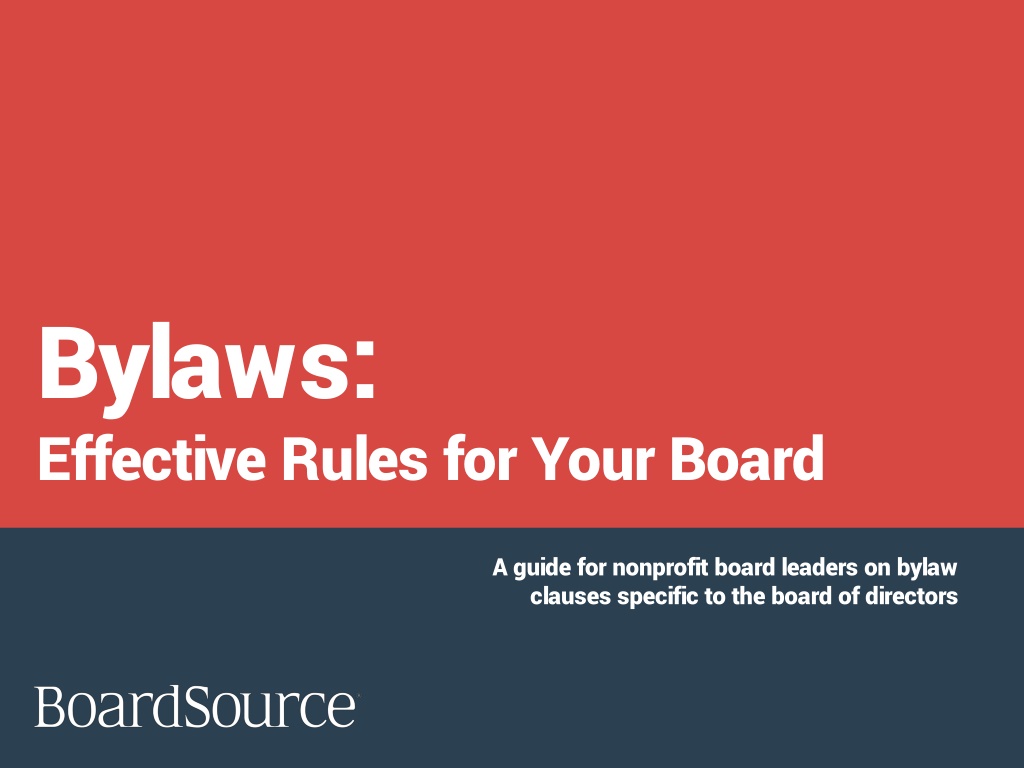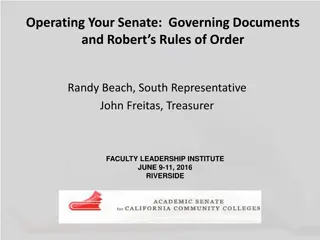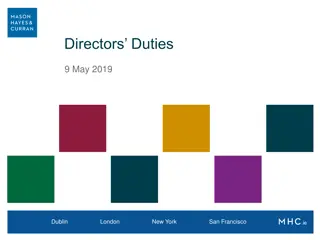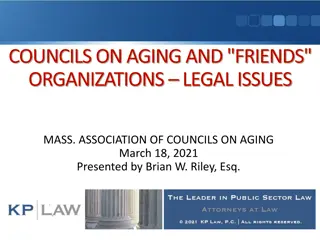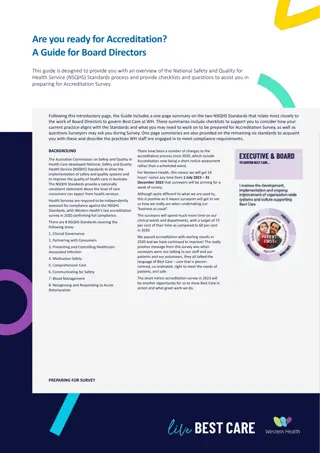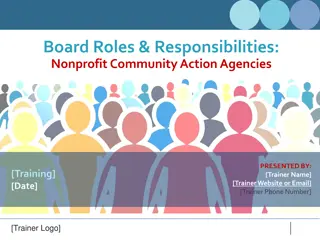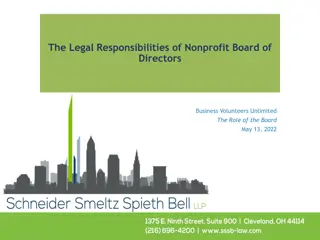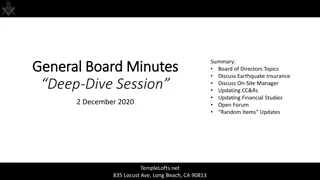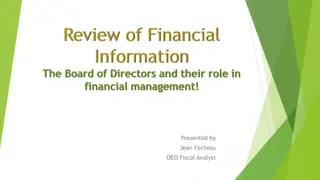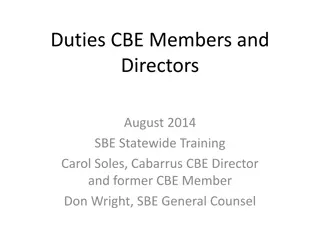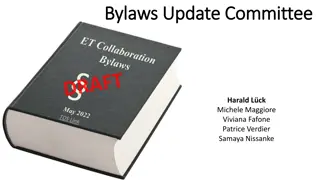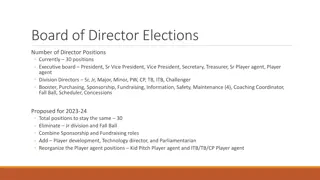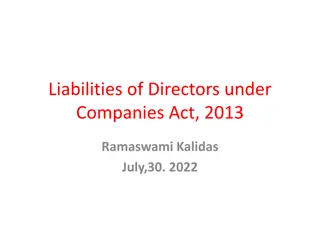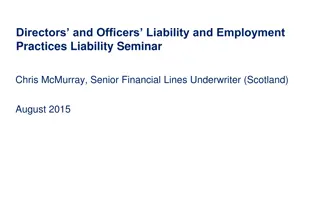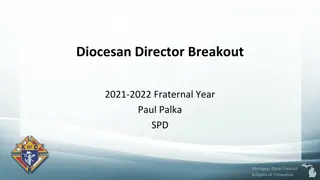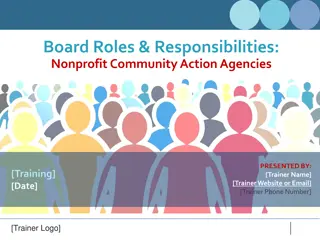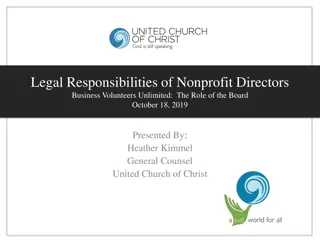Understanding Bylaws for Nonprofit Board of Directors
Essential guide on drafting and understanding nonprofit board bylaws, covering key clauses, governance rules, board structure, and decision-making processes. Bylaws play a crucial role in ensuring effective board operations and legal compliance for nonprofit organizations.
Download Presentation

Please find below an Image/Link to download the presentation.
The content on the website is provided AS IS for your information and personal use only. It may not be sold, licensed, or shared on other websites without obtaining consent from the author. Download presentation by click this link. If you encounter any issues during the download, it is possible that the publisher has removed the file from their server.
E N D
Presentation Transcript
Bylaws: Effective Rules for Your Board A guide for nonprofit board leaders on bylaw clauses specific to the board of directors
Introduction Most nonprofits begin their existence by filing articles of incorporation with the state in which their headquarters is located. Another critical step is to draft a set of bylaws to establish key governance rules. This guide provides some basic information about bylaws and then focuses on those bylaws that pertain specifically to boards of directors. Generally, bylaws should include sections on the following topics: General clauses Members (if applicable) Board of directors Officers Committees Fiscal matters Other issues Carefully crafted bylaws and adherence to them can help ensure effective board decision making and provide protection against legal challenges. It s time to give your bylaws the attention they demand.
Table of Contents The Basics and General Bylaws Key Bylaws for the Board of Directors Other Bylaws Pertaining to the Board Where to Find More Information
THE BASICS Every nonprofit needs to pay careful attention to its bylaws. What happens in a controversy? How are board members and officers elected? How are committees formed?
THE BASICS The 3 Important Functions of Bylaws: To determine structure To determine the rights of participants To determine procedures by which rights can be exercised
GENERAL BYLAWS General Key Bylaws Clauses Official name of the organization Location of principal office Statement of purpose Any limitations required for tax exemption Procedure for disposition of assets upon dissolution
BOARD OF DIRECTORS We ll address these questions and more in the following section: Nonprofit corporations are governed by a board of directors (sometimes called trustees). State law requires that there be a board of directors the body with ultimate decision-making authority and responsibility for the organization. How many directors will be on the board? What are the terms? Are they compensated? How many times should the board meet? Should there be an executive committee?
BOARD OF DIRECTORS Numbers and Selection 1. Numbers of Members Many states require that the bylaws specify the exact number of directors. If your laws do not, providing ranges in the number of members helps provide flexibility and less need to amend the bylaws if someone quickly departs or if you find new talent that fills a needed skill set. A typical statement looks like this: No fewer than 10 nor more than 20. 2. Method of Selection Many board are self perpetuating boards that determine who shall serve and that may re-elect or reappoint current directors. When looking for potential directors, consider what skill sets are needed to align with your organization s strategies, goals, and needs? is your board diverse? Something to think about In calculating the number of directors, consider whether the officers are chosen from among the directors, are directors by virtue of being officers, or are chosen from the general public but are not also part of the board. Commonly, nonprofits elect officers from among the directors. Quick tip CEOs may automatically serve on the board by virtue of their position in the organization. They are referred to as ex officio an ex officio director s voting rights should be clearly specified in the bylaws so there is never any confusion. BoardSource recommends that chief executives have no voting rights.
BOARD OF DIRECTORS Terms and Term Limits 4. Term Limits Based on BoardSource research, most boards use three-year terms; the average maximum limit for board service is two terms. Term limits 3. Terms Many nonprofits boards limit the number of consecutive terms an individual board member may serve and have staggered terms to ensure that there is never a board composed entirely of new members. ensure a variety of perspectives expand your base of contacts within your community help prevent concentration of power among a small group of entrenched leaders Quick tip Regardless of whether the terms are limited and staggered, it s a good practice to evaluate the performance of all board members before any current director is nominated for re- election. Something to think about Don t want to lose a high-performing board member who has completed the maximum number of terms? Think about having them take a year-long sabbatical and then rejoining the board.
BOARD OF DIRECTORS COI and Compensation 5. Conflicts of Interest (COI) 6. Compensation The IRS encourages nonprofits to adopt a conflict-of-interest policy to avoid any unlawful personal benefit to directors and officers. Many nonprofits include a phrase in the bylaws referencing a standalone COI policy. The vast majority of nonprofit board members serve as unpaid volunteers. The bylaws should state whether or not directors are to be compensated. Something to think about: While most states do permit nonprofit directors to be compensated, some states specifically prohibit loans by a nonprofit to its directors. Due to IRS intermediate sanctions, it is prudent to consult legal counsel before paying a salary or sum to directors and officers. Quick tip At a minimum, a COI policy should define what a COI is, require disclosure to the full board of any actual or potential conflict by any director, have the board decide if a true conflict exists, and preclude the director from voting on any transaction(s) in which the director has a conflict.
BOARD OF DIRECTORS Meetings and Committees 8. Committees While some nonprofits list their permanent standing committees in their bylaws, others do so in a separate document outside the bylaws. This allows the board to make changes to its committee structure without a formal bylaw change. A simple bylaws statement might say the board may establish and disband committees as needed to support its work. 7. Meetings Nearly all states require at least one annual meeting for all boards. BoardSource believes boards should have more, as one is insufficient for boards to address all the issues they need to pay attention to. Bylaws should address meeting frequency and procedures (e.g., action without a meeting), the number of members necessary to call a special meeting and who may call it, and the use of virtual meetings. Executive Committee: BoardSource encourages all boards to carefully analyze its structure to determine if an executive committee would add value. If you choose to have one, the bylaws should identify its purpose and address limitations on its authority. Quick tip: It is important to comply precisely with state laws regarding meeting notification.
BOARD OF DIRECTORS Quorum and Voting 10. Voting by Proxy and Virtually Can directors vote by proxy? Usually not. Most state laws stipulate that directors must vote in person or electronically during a virtual meeting. It is important to familiarize yourself with your state laws before allowing electronic voting, however. Your bylaws should address the issue of proxy and electronic voting. 9. Quorum A quorum is the minimum number of people who must be present to hold a valid meeting and take action. Quorum may be set by state law and should be specified in the bylaws. Most laws provide that a quorum is the majority of voting directors in office; one-third is often the lowest allowable number. Something to think about: What happens if some board members leave during a meeting? Can votes be taken after quorum is lost? The answer is not clear! Consider the following: Handle all voting matters early in a meeting, consult state law or legal counsel, prohibit voting once quorum is lost, or allow voting only on routine matters. Quick Tip Careful consideration should be given to whether the board should act without a majority of its member present. It can send the wrong message about board meeting attendance and result in a small number of directors taking action that binds the entire organization.
BOARD OF DIRECTORS Officers and Removal of Directors 11. Officers The positions of volunteer board officers and their duties are stated in the bylaws. Duties are typically defined in broad and flexible terms so that duties can easily be changed without amending the bylaws. The bylaws should state whether officers must be directors with voting power. Some state laws prohibit a person from serving simultaneously in two positions. Limitations of this kind should be stated in the bylaws. 12. Removal of Directors To encourage attendance, some boards have bylaw provisions that allow the automatic removal of directors who miss a specified number of meetings. Bylaws also often include provisions that describe the removal of directors with or without cause. Quick tip Nonprofits sometimes create vice-chair or chair- elect positions to groom a person for succession to the chair position. The bylaws should state that the vice chair or chair- elect will automatically move into the chair position. Something to think about Removal without cause can help avoid lawsuits. The person being removed cannot dispute the reason because no reason needs to be stated.
ADDITIONAL SECTIONS OF BYLAWS Other topics addressed in bylaws pertaining to the board: Fiscal matters: audits, insurance, check-signing, bonding, indemnification, standards of conduct/codes of ethics
MORE ON BYLAWS For more on this topic, visit boardsource.org This guide was adapted from Better Bylaws: Creating Effective Rules for Your Nonprofit Board, Second Edition
